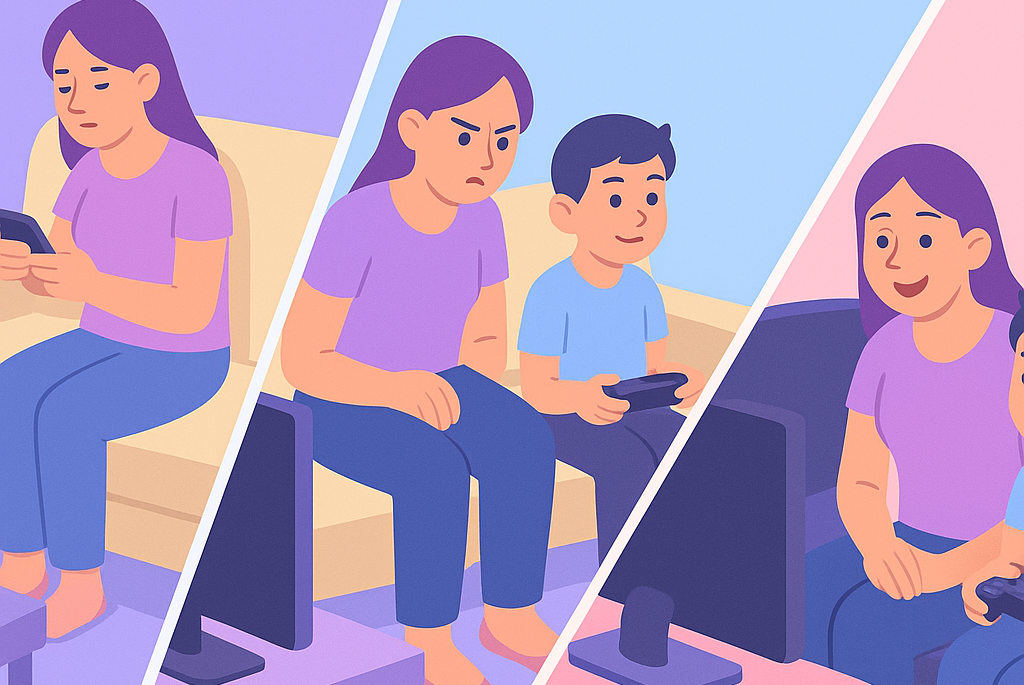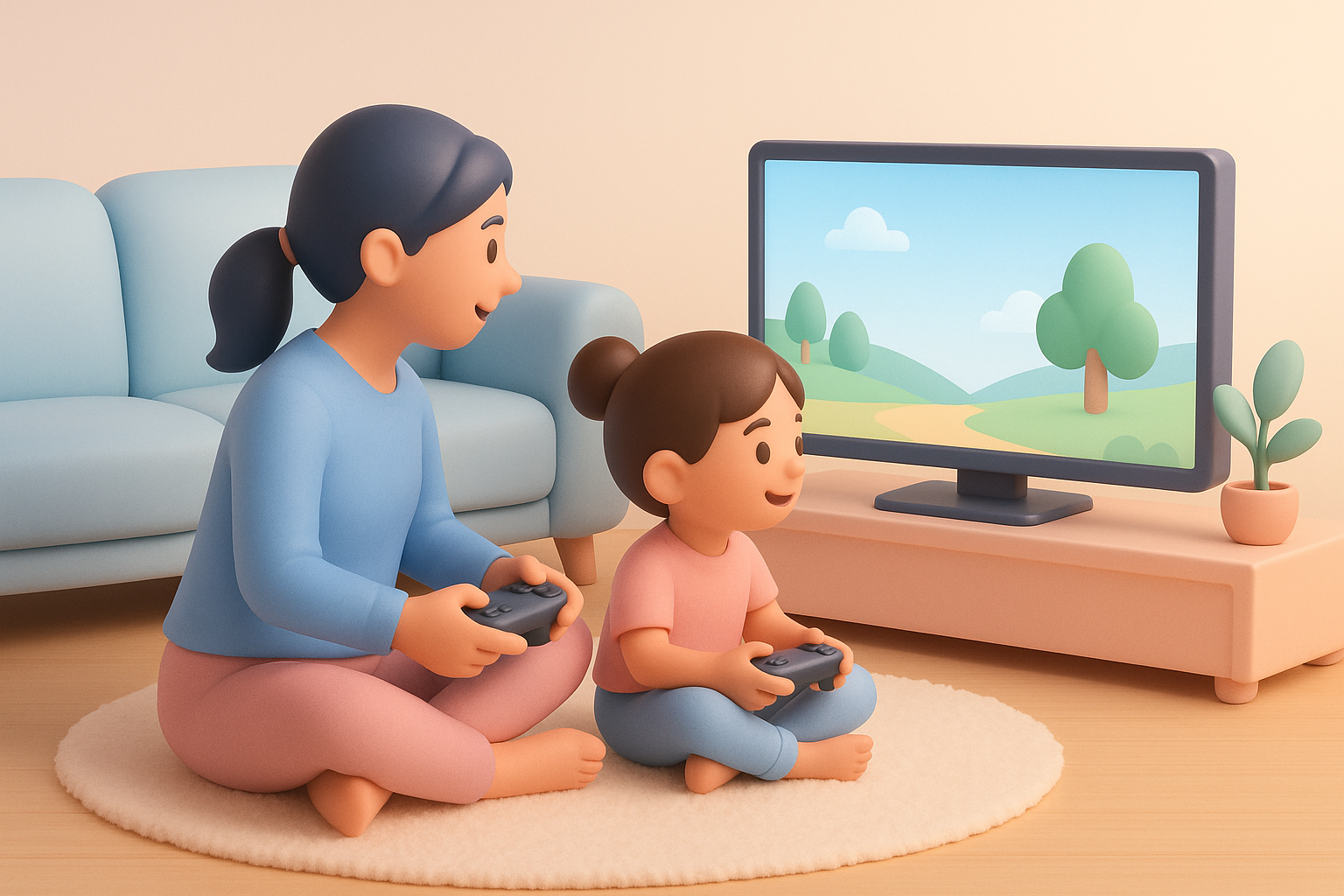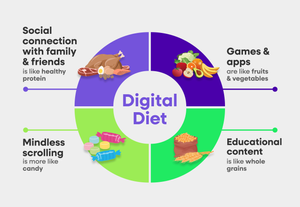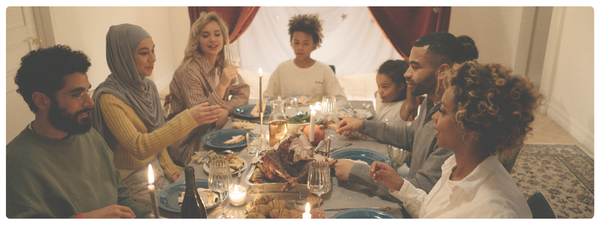While I do love the game for all the fun, challenge, creativity, and collaboration all it affords its players, I must admit that Minecraft is not one of my own go-to games. I struggle with the spatial rotation and 3D awareness it requires.
But my daughter, six years old at the time, had pleaded with me to play it with her. When I finally made the time to sit down and co-play with her, I was blown away. Not by the game itself — by her teaching it to me.
Her kind, gentle, patient approach to showing me how everything worked opened my eyes to her breadth of knowledge and her ability to be my teacher. Not only did I learn from her, I learned about her. And she lit up with the role of instructor.
That’s the power of playing video games together (co-play) as a family: connection, cooperation, communication and undergoing emotional growth, together.
Connection, Not Supervision
Keeping an eye on your kids’ “game lives” is surely a bonus of co-playing digital games, but it’s definitely not the main goal. It’s about showing you’re interested in what they’re interested in. Getting down on their level, being present, and joining them in the fun — not just witnessing it.
Scrolling Instagram while your kids play soccer isn’t playing with them (or witnessing for that matter). Neither is it co-play if you’re reading a book while they’re dodging turtle shells in Mario Kart. When we’re really present with them, we’re modeling curiosity, empathy, vulnerability, bravery, resilience — the list goes on — while just plain having fun.
Think about it this way: just like you might go outside to kick a soccer ball around or shoot hoops in your driveway, you can use digital play to unwind and create connective moments of fun, laughter, challenge, and discovery. Co-play is just like playing these backyard sports together, just with a virtual ball on a screen-sized field (sometimes, quite literally — FIFA anyone?).
It’s the presence and the engagement that matter.

Co-play is hugely beneficial to our kids and to our family bonds. It provides scaffolding for learning, cooperation, and digital literacy that they’ll continue to build on when we’re not directly engaged with them.
Let’s dig into what co-play really is, why it matters, and just how beneficial it really is to play video games together as a family.
What “Co-Play” Means and Why It Matters
Co-play is just what it sounds like: sharing in the video game together with our kids, not just supervising or second-screening in the background. It’s the modern equivalent of a family game night, the game just happens to be on a screen.
Studies show the enduring positive impacts of playing video games together, much like how joining your kid on the playground can be more developmentally, socially, and emotionally beneficial than sitting on the park bench. Research points out the opportunities for kids to practice problem-solving, persistence, empathy, and emotional regulation in safe, engaging ways. Families share in the benefits, learning and growing together.
The Entertainment Software Association highlights numerous “Essential Facts” about video game use in the U.S in support of this thinking, too:
- 82% of parents who play video games bring their kids into the action
- 52% of those parents engage in co-play at least weekly
- Nearly 70% of parents say they prefer their kids to play video games rather than use social media
All in all, it’s starting to seem pretty obvious that playing video games together is a perfect way to stay connected to our kids, and help them develop life skills in our modern digital era.
Another study specifically explored the social and cooperative aspects of games that make them especially powerful tools for strengthening family bonds. It found that families who play video games together report greater family satisfaction and closeness. Interestingly, co-play had the strongest positive impact in families that initially struggled with communication, suggesting that gaming can help bridge emotional gaps.
Think about it — as kids, we play so much, but that playtime tapers off as we get older. Digital games give us a way to keep our playfulness alive and easily share it with our families, strengthening our most important relationships.
How to Start Co-Playing (and Make It Stick)
For some parents, stepping into co-play seems uncomfortable or complicated. Yet the goal is not to become a gamer overnight or immediately mesh with how your kids play. The point is to show up at all, and even better show up with curiosity, playfulness, and a sense of humor.
And a willingness to fail gracefully, lose humbly, and learn from the little ones you’re usually teaching.
Start with games your kids already play, especially those that put everyone on even footing. Pick a game that’s easy to pick up and doesn’t require tons of skill or experience. Mario Kart, Mario Party, or Animal Crossing are great choices. Minecraft is wonderful, too, but it can be a little more advanced for beginners. Surprising no one, I’m also a big fan of Nurture, which intentionally bakes in even more life skill development.
Try setting aside a dedicated “family gaming night,” just like you might for board games or movie night. In my house, Friday nights are for exactly that. Sometimes we pick up a board game, but more often than not, we have a controller or tablet in hand.
Don’t worry too much about spending X amount of time gaming together. Let it play out naturally. The key is consistency and connection, not duration.
Remember to talk as you play. Usually, the conversation and exclamations will come naturally, but you can also spur reflection and discussion:
- What do you like about this game or level?
- Why is this stage so frustrating?
- If you could make it easier or harder, what would you change?
Celebrate the wins, laugh about the losses. Whether they’re totally owning you or you’re jumping off a digital ledge to keep your scores within playful distance, don’t worry too much about going easy on them or matching their skill level.
Just be in the moment.

Don’t be afraid, or hesitant, or insecure — you don’t have to immediately “get it.” One thing I’ve found to be hilariously true is that family video game night is often more fun when you’re bad at it. Just be prepared to laugh at yourself!
When you fumble a jump or miss a turn, you’re showing your kids what persistence looks like in action. More importantly, you’re showing them that you trust them, too, as a safe space for experience and failure. I promise, they’ll appreciate that and impress you with their empathy, guidance, and encouragement.
OK, they might poke fun at you a bit. But it’s all in good fun!
Here’s a few parting tips to get you started on your co-play adventures
- Start small and cooperatively: Play, work, win, and lose together, to keep it positive and inclusive.
- Keep it short and playful: Focus on shared joy, not endurance.
- Mix on-screen and off-screen play: Treat digital play as one part of a balanced experience, whether that means swapping in a board game now and then or re-enacting your character’s victory dance.
- Model digital literacy: Show how to pause, check settings, or take breaks.
- Keep it light: Remember to embrace cooperation, not supervision.
Your kids are going to play video games with or without you — why not enjoy it with them?
Co-Play FAQs
What if I’m not “good” at video games?
Guess what: it’s even more fun when you’re bad at it! Co-play is about connection, modeling, and learning together, not outright skill. Fear of failure is the biggest barrier for parents. But when you’re clumsy at a game, you’re modeling persistence and showing your kids that it’s okay to learn new things.
Even asking questions or taking turns on simple levels models curiosity and teamwork, which strengthens your bond and helps kids practice patience and empathy.
What kinds of games are best for family co-play?
Look for cooperative or creative games that emphasize exploration, storytelling, or teamwork. Think Minecraft, Mario Kart, or Animal Crossing. Don’t try to over-optimize on teachable moments within the game itself. Every video game has something to offer!
How do I keep gaming from turning into conflict (or power struggles) at home?
Like any shared activity, co-play works best with clear expectations and a little humor. Treat it like board game night: decide together when you’ll play, for how long, and what happens when someone gets frustrated. Some games, like Risk (or long Minecraft survival sessions), can stretch patience, so start small and cooperative.
When frustration does pop up, it’s actually a built-in opportunity for growth. Kids learn how to manage disappointment, express frustration respectfully, and move on. Modeling calm, laughter, and taking breaks shows them that big feelings are part of the process and that connection always comes first.






 Copy Link
Copy Link
 Share
to X
Share
to X
 Share
to Facebook
Share
to Facebook
 Share
to LinkedIn
Share
to LinkedIn
 Share
on Email
Share
on Email




